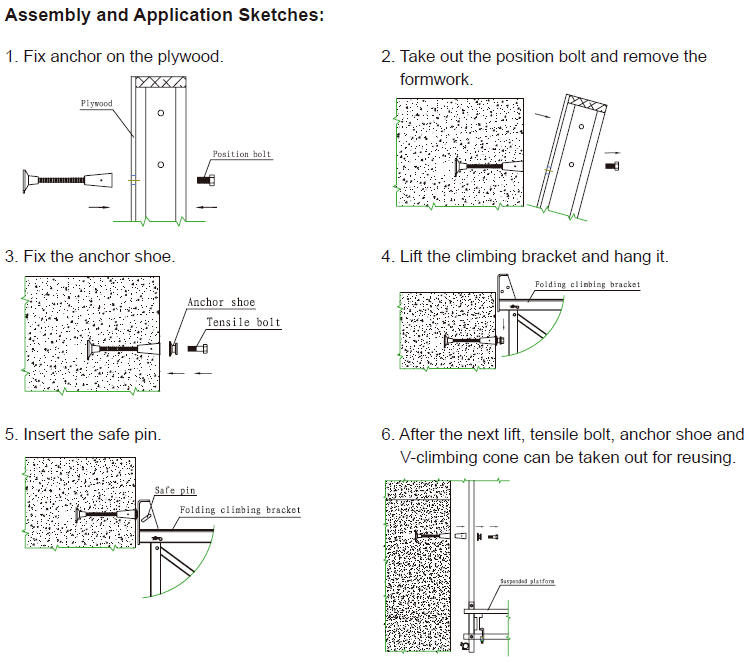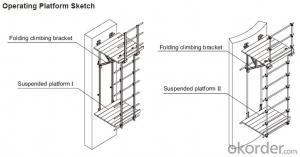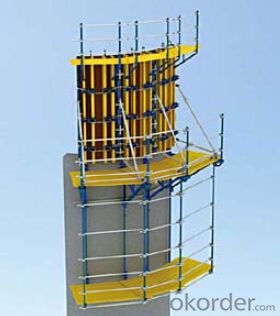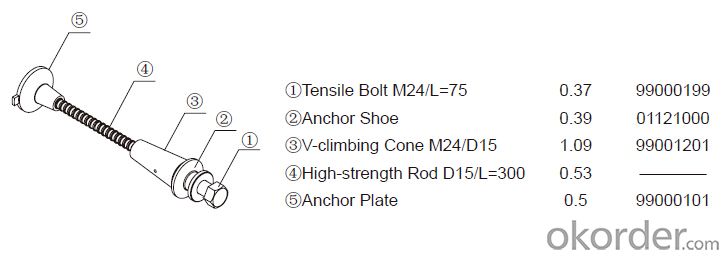Climbing platform CP190 for formwork and scaffolding system
- Loading Port:
- Tianjin
- Payment Terms:
- TT OR LC
- Min Order Qty:
- 50 m²
- Supply Capability:
- 1000 m²/month
OKorder Service Pledge
OKorder Financial Service
You Might Also Like
Climbing Platform CP190
Climbing bracket CP190 is mainly used as operating platform during construction. It can be used
on the vertical wall and arced wall. The bracket hang on the anchor system and all the load are
supported by anchor system. It’s convenient to assemble and dismantle, the construction is easy,
rapid and safe.
Anchor System:
Anchor system is the most important supporting part. The system is made of five parts shown
below. There into, tensile bolt, anchor shoe and V-climbing cone can be taken out for reusing.

- Q: Can steel formwork be used for office building construction projects?
- Yes, steel formwork can be used for office building construction projects. Steel formwork offers several advantages such as high strength, durability, and reusability, making it suitable for constructing office buildings with complex designs and multiple levels. It allows for fast and efficient construction, ensuring a smooth workflow and meeting project deadlines. Additionally, steel formwork provides a stable and sturdy framework for concrete pouring, ensuring structural integrity and high-quality finishes for office buildings.
- Q: Are there any safety considerations when using steel formwork?
- Yes, there are several safety considerations when using steel formwork in construction projects. Firstly, handling and installing steel formwork panels can be physically demanding due to their weight and size. It is necessary to have proper lifting equipment and trained personnel to safely handle and position the formwork panels to prevent accidents or injuries. Secondly, steel formwork should be securely supported and braced to ensure stability during concrete pouring. Proper anchoring and shoring systems should be in place to prevent collapse or displacement of the formwork, which can lead to serious accidents. Additionally, working at heights while installing or removing steel formwork can pose a risk of falls. It is important to provide suitable fall protection measures such as guardrails, safety nets, or personal fall arrest systems to prevent workers from falling from elevated surfaces. Furthermore, steel formwork may have sharp edges or protruding parts that can cause lacerations or puncture wounds. Workers should be provided with appropriate personal protective equipment (PPE) such as gloves, safety boots, and eye protection to minimize the risk of injury. Moreover, steel formwork should be regularly inspected for any signs of damage or deterioration. Any damaged or weakened components should be replaced promptly to maintain the structural integrity and safety of the formwork system. Lastly, proper communication and coordination among workers is essential to prevent accidents. Clear instructions, training, and supervision are necessary to ensure that all workers understand and follow the safety procedures when using steel formwork. Overall, by adhering to these safety considerations and implementing appropriate safety measures, the risks associated with using steel formwork can be minimized, creating a safer working environment for construction personnel.
- Q: Can steel formwork be used in educational or institutional construction projects?
- Yes, steel formwork can be used in educational or institutional construction projects. Steel formwork is commonly used in various construction projects, including those in the educational and institutional sectors. It provides a durable and versatile solution for casting concrete structures, ensuring the strength and stability required for these types of projects. Additionally, steel formwork allows for efficient construction processes, reducing the overall project duration and costs.
- Q: How does steel formwork affect the overall flexibility of the construction process?
- Steel formwork can significantly impact the overall flexibility of the construction process. One of the key advantages of using steel formwork is its high strength and durability. This allows for the creation of complex and intricate structures while maintaining the structural integrity of the formwork system. The use of steel formwork provides greater flexibility in terms of design and construction. It allows for the creation of more precise and accurate shapes, resulting in a higher level of architectural sophistication. Steel formwork also offers the ability to reuse the formwork multiple times, reducing costs and increasing efficiency in construction projects. Moreover, steel formwork enables faster construction progress due to its ease of assembly and disassembly. This allows for shorter construction cycles, saving time and resources. The flexibility of steel formwork also allows for adjustments and modifications during the construction process, providing the opportunity to adapt to unforeseen changes or design revisions. In addition, steel formwork offers enhanced safety and stability, ensuring a secure working environment for construction workers. Its high load-bearing capacity allows for the construction of taller and more complex structures, expanding the possibilities in architectural design. Overall, the use of steel formwork improves the overall flexibility of the construction process by enabling the construction of complex structures, providing design adaptability, reducing construction time, and enhancing safety. Its strength, durability, and reusability make it a preferred choice in the construction industry, allowing for greater efficiency, accuracy, and innovation in building projects.
- Q: What are the different types of accessories available for steel formwork?
- Steel formwork offers a range of accessories designed to improve the efficiency and effectiveness of the system. Several common types of accessories include: 1. Clamps - These securely connect formwork panels, providing stability and preventing movement during concrete pouring. 2. Wedges - These level and align the panels by inserting them between the panels and tightening for a secure fit. 3. Ties - Made of steel, these secure formwork panels to the structure by inserting them through panel holes and anchoring them. 4. Connectors - These join panels at corners or junctions, maintaining the formwork system's structural integrity. 5. Spacers - These maintain a specific distance between panels, ensuring the desired concrete thickness. 6. Brackets - These support formwork panels during construction, preventing sagging or bending. 7. Release agents - Applied to panels before pouring concrete, these prevent adhesion, allowing for easy removal once the concrete sets. 8. Handles - These facilitate handling and positioning of panels, providing a secure grip for proper placement. 9. Chamfers - These create beveled edges on concrete, attached to panels for a finished look. 10. Accessories for special applications - Specialized accessories exist for curved structures, columns, and beams. These examples highlight the range of accessories available for steel formwork. The choice of accessories depends on project requirements and desired outcomes. Selecting the appropriate accessories is crucial for a successful and efficient formwork system.
- Q: Can steel formwork be used for both vertical and horizontal concrete structures?
- Yes, steel formwork can be used for both vertical and horizontal concrete structures. Steel formwork is highly versatile and can be easily adjusted and assembled to create various shapes and sizes for different structures. It provides strong support, stability, and durability, making it suitable for both vertical walls and horizontal slabs. Steel formwork also offers excellent dimensional accuracy, ensuring precise concrete placement and alignment. Additionally, steel formwork is reusable, which makes it a cost-effective option for construction projects that require repetitive use of formwork systems.
- Q: What is the lifespan of steel formwork?
- The lifespan of steel formwork can vary depending on various factors such as the quality of the steel, maintenance practices, and frequency of use. However, with proper care and maintenance, steel formwork can last for many years, potentially even decades.
- Q: How does steel formwork affect the overall construction site waste recycling?
- Steel formwork positively affects the overall construction site waste recycling by reducing the amount of waste generated. Unlike traditional timber formwork, steel formwork is durable and reusable, resulting in less material wastage. It also contributes to the efficient use of resources as it can be easily dismantled and repurposed for future projects, minimizing the need for new materials. This reduces the environmental impact and promotes sustainability in the construction industry.
- Q: Can steel formwork be used for both regular and irregular concrete structures?
- Both regular and irregular concrete structures can be constructed using steel formwork. Steel formwork is extremely versatile and can be easily tailored to fit any shape or size of the structure. This makes it suitable for constructing both regular structures with standard dimensions and irregular structures with unique shapes and designs. The flexibility of steel formwork allows for efficient construction of various types of concrete structures, such as walls, columns, beams, slabs, and even intricate architectural features. Moreover, steel formwork provides high strength and durability, ensuring that it can withstand the pressure and weight of the concrete during the pouring and curing process, regardless of the structure's regular or irregular shape. In summary, steel formwork is a dependable and adaptable option for constructing both regular and irregular concrete structures.
- Q: Can steel formwork be used for both cast-in-place and precast concrete structures?
- Yes, steel formwork can be used for both cast-in-place and precast concrete structures. Steel formwork is versatile and can be easily adjusted and reused for different projects, making it suitable for both construction methods.
Send your message to us
Climbing platform CP190 for formwork and scaffolding system
- Loading Port:
- Tianjin
- Payment Terms:
- TT OR LC
- Min Order Qty:
- 50 m²
- Supply Capability:
- 1000 m²/month
OKorder Service Pledge
OKorder Financial Service
Similar products
Hot products
Hot Searches
Related keywords




















